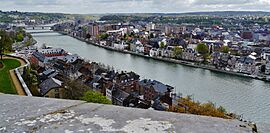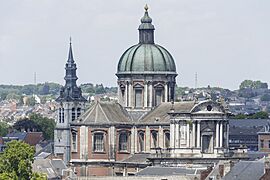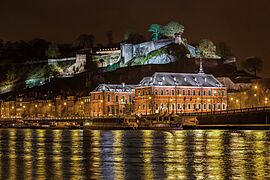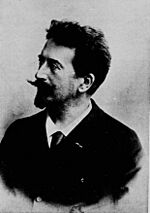Namur facts for kids
Quick facts for kids
Namur
Nameur (Walloon)
Namen (Dutch)
|
|||
|---|---|---|---|
|
|||
| Country | Belgium | ||
| Community | French Community | ||
| Region | Wallonia | ||
| Province | Namur | ||
| Arrondissement | Namur | ||
| Area | |||
| • Total | 175.69 km2 (67.83 sq mi) | ||
| Population
(2018-01-01)Lua error in Module:Wd at line 1575: attempt to index field 'wikibase' (a nil value).
|
|||
| • Total | Lua error in Module:Wd at line 1,575: attempt to index field 'wikibase' (a nil value). | ||
| Postal codes |
5000, 5001, 5002, 5003, 5004, 5020, 5021, 5022, 5024, 5100, 5101
|
||
| Area codes | 081 | ||
| Website | www.namur.be | ||
|
|
|||
Namur is an important city and municipality in Wallonia, Belgium. It is the capital city of the Namur province. Namur is also the capital of Wallonia itself. This means it is home to the Parliament of Wallonia, the Government of Wallonia, and its main offices.
The city is located where two rivers meet: the Sambre and the Meuse. Namur sits across three different areas: Hesbaye to the north, Condroz to the south-east, and Entre-Sambre-et-Meuse to the south-west. The city of Charleroi is to the west. People in Namur mostly speak French.
The municipality of Namur includes many smaller towns and villages. Some of these are Beez, Belgrade, Boninne, Bouge, Champion, Dave, Jambes, and Malonne.
Contents
A Look Back: Namur's History
How Namur Began
Namur started as a key trading place long ago, during Celtic times. It was on important trade routes that crossed the Ardennes region. The Romans came here after Julius Caesar defeated the local Aduatuci tribe.
Namur became more important in the early Middle Ages. The Merovingians built a castle or fortress on a rocky hill. This hill overlooked the town where the two rivers met. In the 10th century, Namur became its own county. The town grew unevenly. The counts of Namur could only build on the north side of the Meuse river. The south side belonged to the bishops of Liège. This area grew slower and became the town of Jambes, which is now part of Namur.
In 1262, Namur was taken over by the Count of Flanders. Later, in 1421, Duke Philip the Good of Burgundy bought it.
Namur Under Different Rulers
Namur became part of the Spanish Netherlands in the 1640s. Its citadel, or fortress, was made much stronger. Louis XIV of France attacked in 1692. He captured the town and made it part of France. His famous military engineer, Vauban, rebuilt the citadel.
French control did not last long. William III of Orange-Nassau captured Namur just three years later in 1695. This happened during the War of the Grand Alliance. Later, the Barrier Treaty of 1709 allowed the Dutch to keep soldiers in Namur. The Peace of Utrecht in 1713 gave control of the former Spanish Netherlands to the Austrian House of Habsburg. So, the Austrians ruled the town, but the Dutch controlled the citadel. They rebuilt it again during their time there.
In 1792, French forces attacked the city. After 12 days, Namur surrendered. France invaded the region again in 1794. They took over Namur and ruled it strictly. After Napoleon was defeated in 1815, Belgium became part of the United Kingdom of the Netherlands. Belgium gained independence in 1830 after the Belgian Revolution. Namur remained an important military town. The citadel was rebuilt once more in 1887.
Namur in Modern Times
In World War I, Namur was a main target for the German invasion. Germany wanted to use the Meuse valley to get into France. On August 21, 1914, the Germans attacked Namur without warning. Many people were killed. Even though the citadel was thought to be very strong, it fell in just three days. The Germans occupied the town for the rest of the war.
Namur also suffered a lot in World War II. It was on the front lines during the Battle of the Ardennes in 1940 and the Battle of the Bulge in 1944. The town was badly damaged in both wars.
Namur used to host the Belgian Army's paratroopers. They left the city in 1977.
After the Walloon Region was created, Namur was chosen as its capital. This means it became the home for the region's executive and parliament. In 1986, Namur was officially declared the capital of Wallonia. Its role as regional capital was confirmed again in 2010.
Namur's Economy
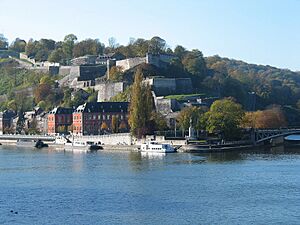
Namur is a key center for business and industry. It is located in an important industrial area called the Sambre and Meuse valley. The city produces things like machinery, leather goods, metals, and porcelain.
The railway station is a major hub. It connects Brussels and Luxembourg City (north-south). It also links Lille and Liège (east-west). River barges also travel through the city on the Meuse river.
Culture and Things to See
Namur has become a popular place for tourists. This is partly because it is the capital of Wallonia. Its location at the start of the Ardennes region also makes it a good base for visitors. There is a casino in the southern part of the city, by the Meuse river.
The most famous sight in Namur is the Citadel of Namur. It is no longer used for military purposes and is open to the public. Namur also has a beautiful 18th-century cathedral. It is dedicated to Saint Aubain. There is also a belfry (bell tower). This belfry is recognized by UNESCO as a World Heritage Site. It is part of the Belfries of Belgium and France.
The Couvent des Soeurs de Notre-Dame once held amazing artworks by Hugo d'Oignies. These are now shown in the Musée des Arts Anciens. You can also find an archeological museum and a museum about the artist Félicien Rops in Namur.
Unique Traditions
A unique tradition in Namur is the joust on stilts. This custom dates back to 1411. It is performed by the stiltwalkers of Namur. The most important joust is the annual Combat de l'Échasse d'Or (Fight for the Golden Stilt). It happens on the third Sunday of September. Two teams, the Mélans and the Avresses, dress in medieval clothes. They stand on stilts and battle in one of the city's main squares. Since 2021, Namur stilt jousts are on the UNESCO Representative List of the Intangible Cultural Heritage of Humanity.
Education and Festivals
Namur has a respected university, the University of Namur. It was founded in 1831. The University of Louvain also has facilities in the city. Its UCLouvain Namur University Hospital is the largest employer in the province.
Since 1986, Namur has hosted the Namur International Festival of French-Speaking Film. There are also annual jazz (Nam'in'Jazz) and rock (Verdur Rock) festivals.
Sports in Namur
The local football team is called Union Royale Namur. The local baseball team is the Namur Angels.
The annual Namur cyclo-cross race is part of the UCI Cyclo-cross World Cup. It takes place on the hills around the citadel. From 1950 to 2007, the Belgian Motocross Grand Prix was held here. It was a challenging race around the citadel. Thousands of fans came to support Belgian motocross stars. The Namur circuit became famous. It was known as the Monaco of the Motocross World Championships.
Nearby Attractions
Places to visit near Namur include Maredsous Abbey, Floreffe Abbey, and Annevoie Castle with its beautiful Jardins d'Annevoie.
Sister Cities
Namur is connected with other cities around the world. These are called twin towns or sister cities:
 Bandung, Indonesia
Bandung, Indonesia Quebec City, Quebec, Canada
Quebec City, Quebec, Canada Subotica, Serbia
Subotica, Serbia Bourg-en-Bresse, France
Bourg-en-Bresse, France Ōgaki, Gifu Prefecture, Japan
Ōgaki, Gifu Prefecture, Japan Belmont, California, United States
Belmont, California, United States Lafayette, Louisiana, United States
Lafayette, Louisiana, United States Empoli, Toscana, Italy
Empoli, Toscana, Italy Cluj-Napoca, Cluj, Romania
Cluj-Napoca, Cluj, Romania Tierp, Sweden
Tierp, Sweden Pristina, Kosovo
Pristina, Kosovo
Famous People from Namur
Many notable people have come from Namur:
- Rémy Belvaux (1966–2006), an actor and film director.
- Julie Billiart (died 1816), a saint and founder of the Sisters of Notre Dame de Namur.
- Francy Boland (1929–2005), a jazz pianist.
- Cécile de France (born 1975), a well-known actress.
- Olivier Gourmet (born 1963), an actor.
- Ludivine Henrion (born 1984), a cyclist.
- Pierre Jonckheer (born 1951), a politician.
- Philippe Kirsch (born 1947), a Canadian judge and diplomat.
- Louis Leloir (1911–1992), a Benedictine monk.
- Benjamin Lessennes (born 1999), a racing driver.
- Henri Michaux (1899–1984), a French-speaking poet and painter.
- Benoît Poelvoorde (born 1964), an actor and comedian.
- Jacques François Rosart (1714–1777), an engraver.
- Christophe Rochus (born 1978), a tennis player.
- Olivier Rochus (born 1981), also a tennis player.
- Félicien Rops (1833–1898), a graphic artist.
- Thierry Zéno (born 1950), a director.
- Raphaël Liégeois (born 1988), a biomedical engineer and Belgian astronaut.
- Nafissatou Thiam (born 1994), an athlete with three Olympic gold medals in Heptathlon.
Images for kids
-
St Aubin's Cathedral is the only academic Late Baroque cathedral in Belgium.
-
The horse Bayard carrying The Four Sons of Aymon, a sculpture by Olivier Strebelle
See also
 In Spanish: Namur para niños
In Spanish: Namur para niños


